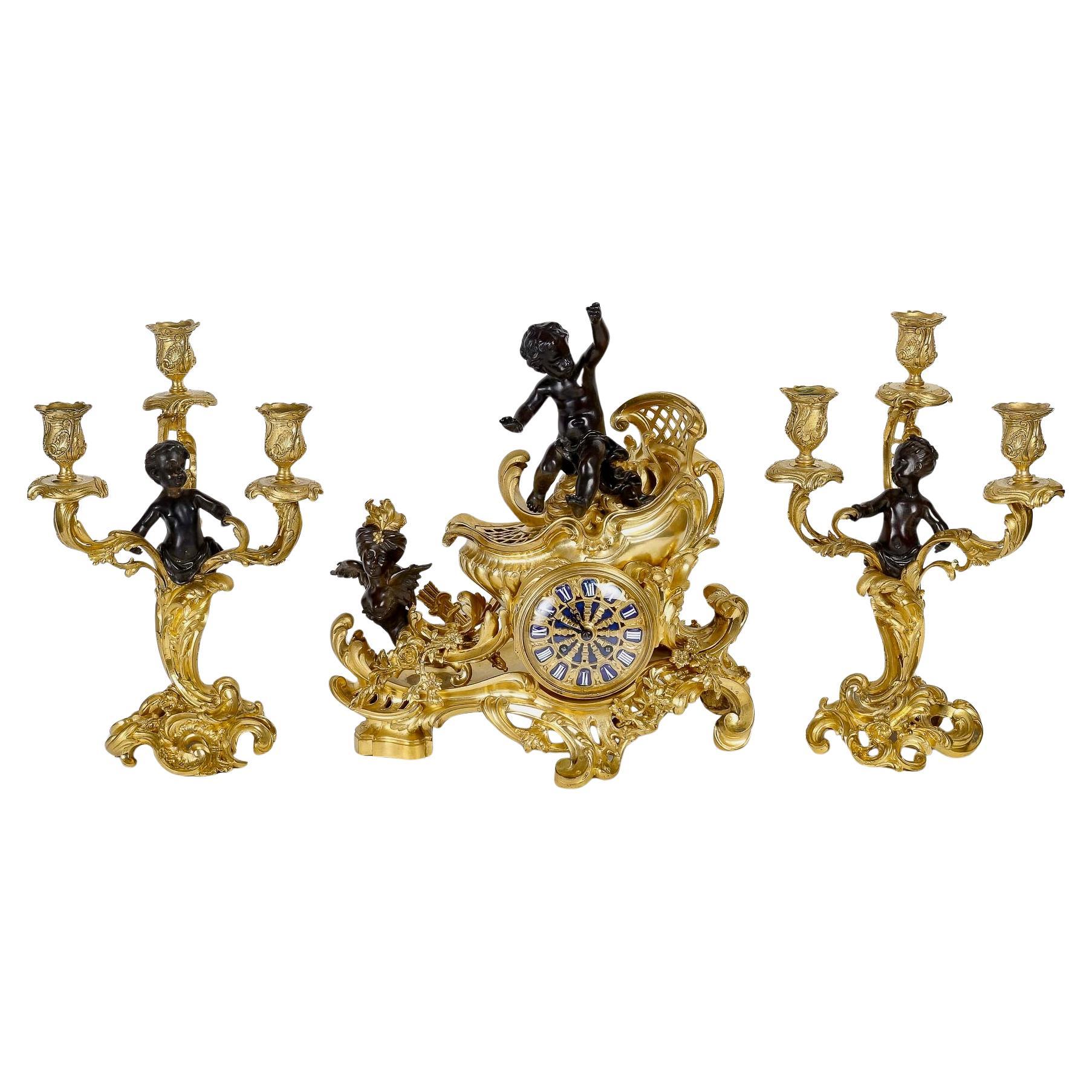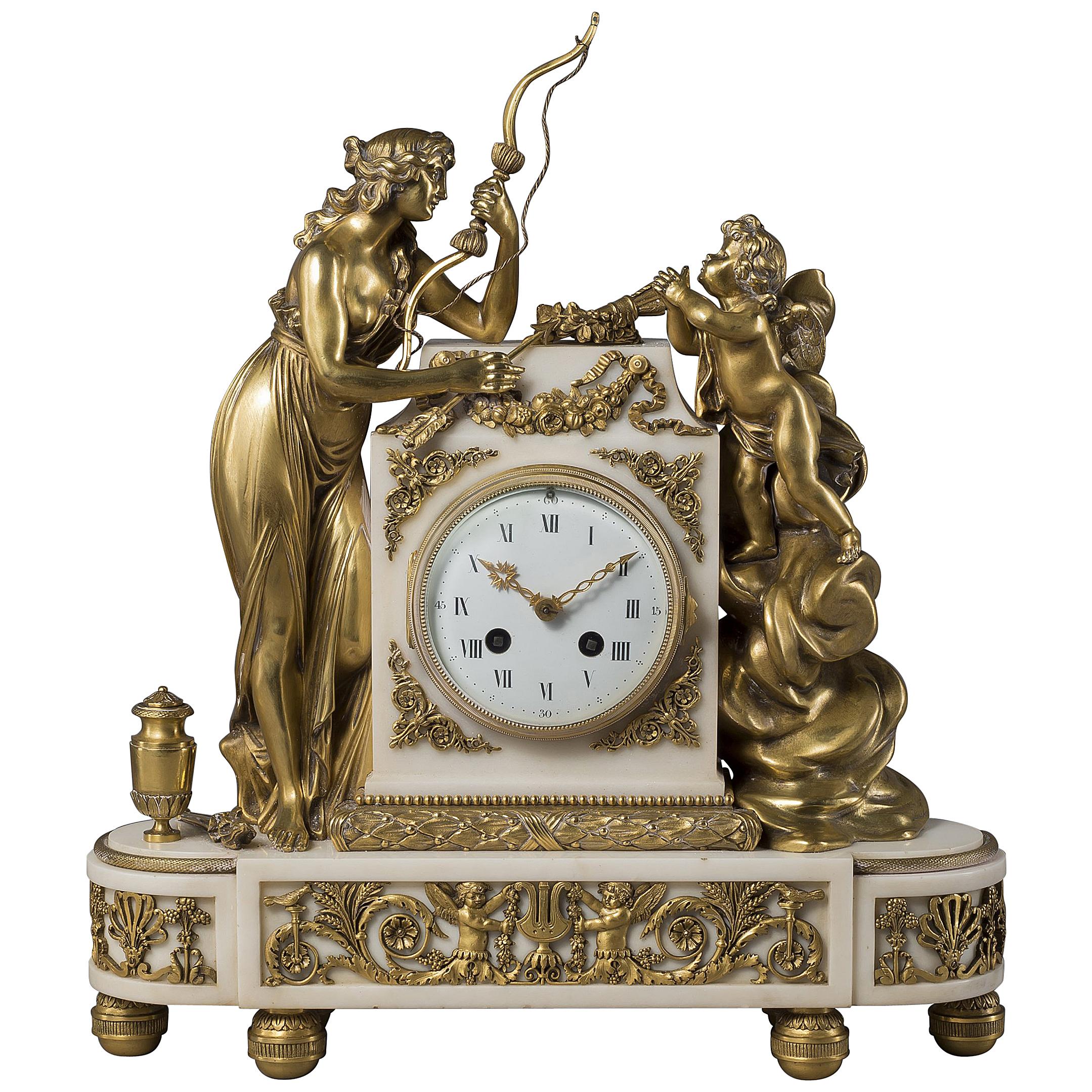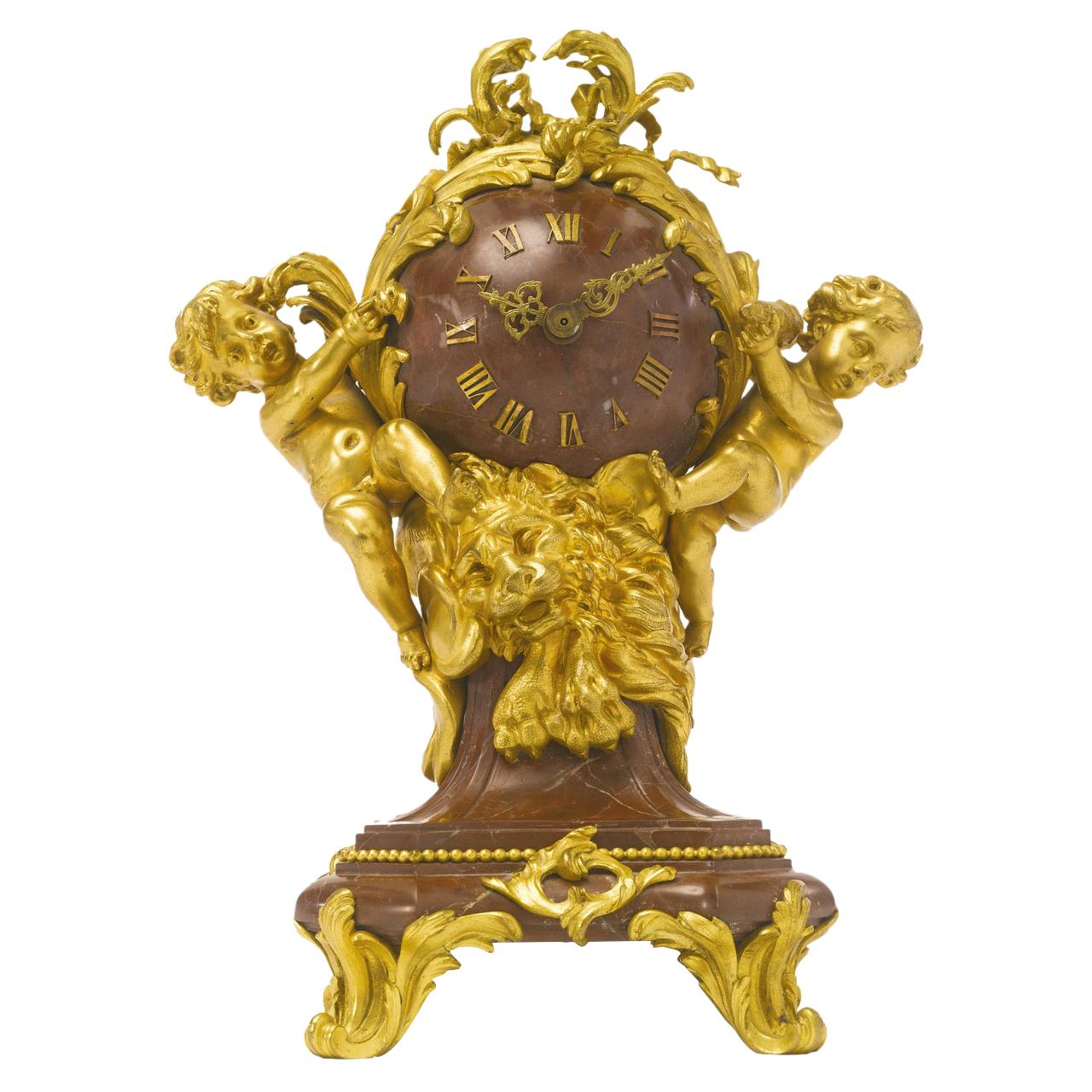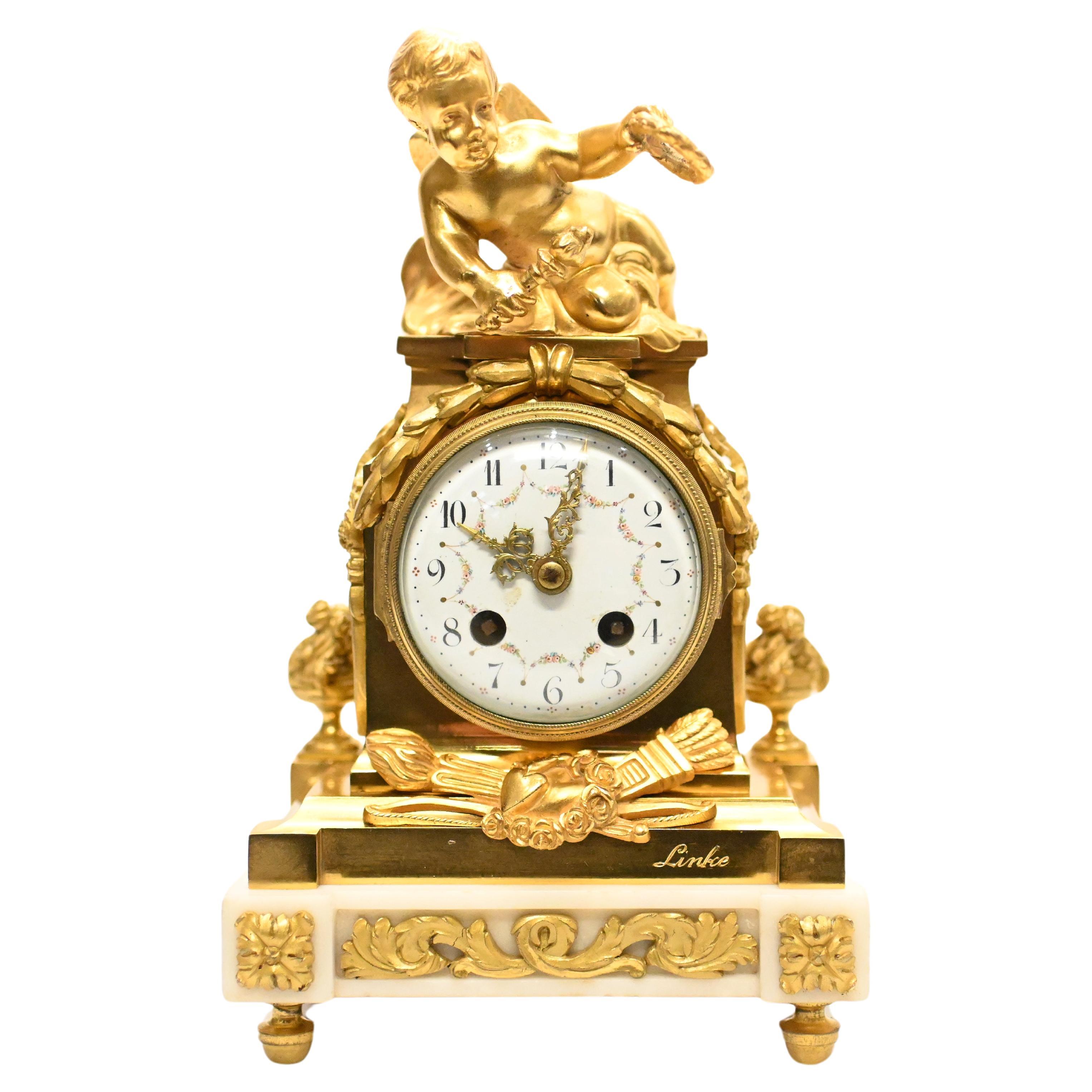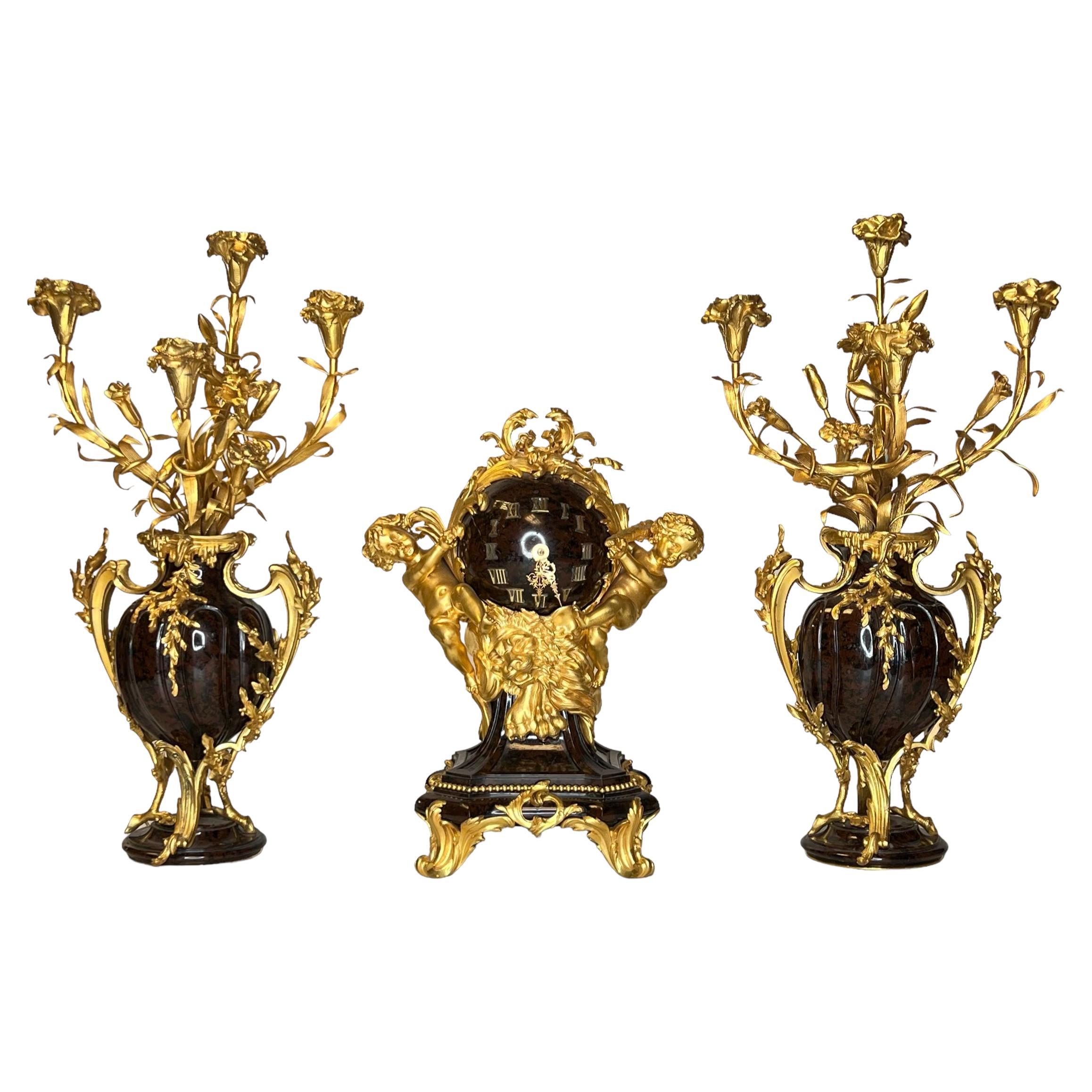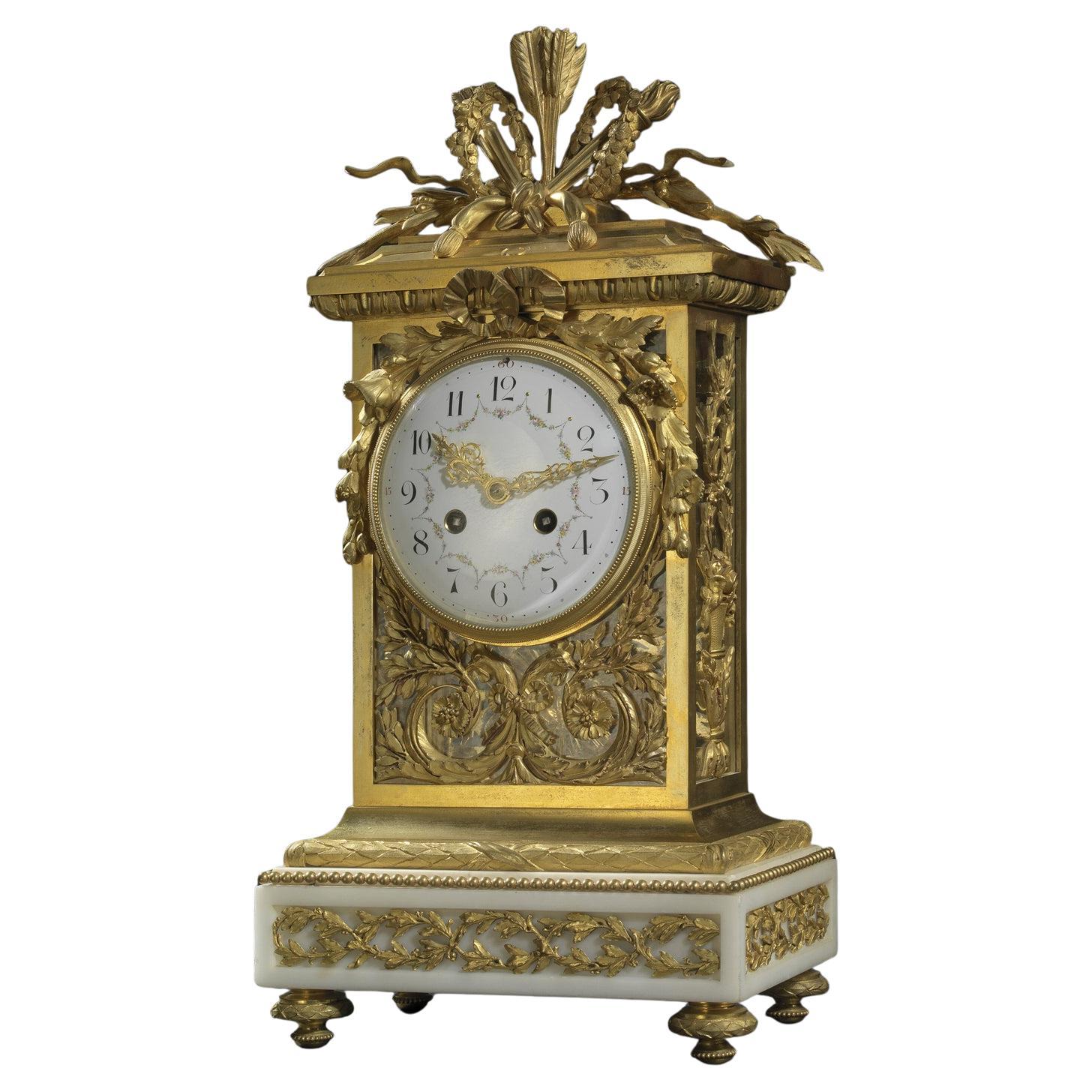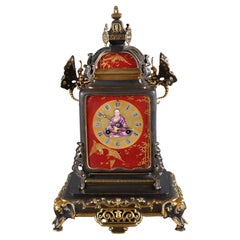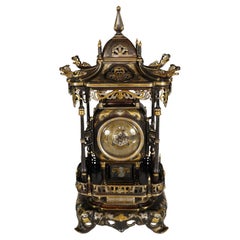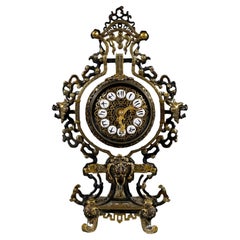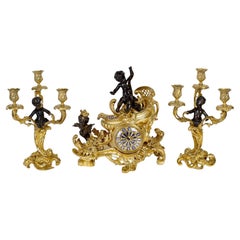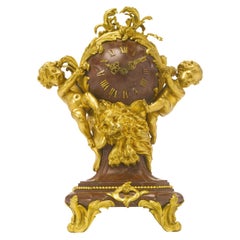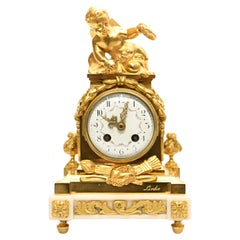Items Similar to "The Source" Gilt bronze Clock attr. to L. Messagé & F.Linke, France, circa 1890
Want more images or videos?
Request additional images or videos from the seller
1 of 9
"The Source" Gilt bronze Clock attr. to L. Messagé & F.Linke, France, circa 1890
About the Item
Charming clock in the shape of a Rocaille-inspired cartel in chiseled and gilded bronze. Scalloped marine-inspired decor representing a trophy with oars, dolphins, reeds and flowers on a trellis background. The white enamel dial is surmounted by an allegory of the Source personified by a Cupid pouring water from a pot and holding an oar. Ending with four arched legs, it rests on a scrolled terrace decorated with acanthus and rocks. The design of this clock is characteristic of the style of Léon Messagé.
Related Work :
Similar gilded bronze clock with the design attribited to L. Messagé.
C. Payne, Francois Linke 1855-1946: The Belle Epoque of French Furniture, Antique Collector's Club Ltd., Woodbridge, 2003, pl. 104, p. 93
Biography :
Léon Messagé is a renowned designer and sculptor who integrated in his ornaments related to the Rocaille asymmetry, new lines and shapes announcing the “Art Nouveau” style. But even though, Messagé found inspiration with these 18th century artists, such as Nicolas Pineau or J. A. Meissonier, he didn’t simply copy their work and showed great originality, even extravagance, with some designs contained in "Cahier des dessins et croquis style Louis XV". He realized numerous sketches on grey paper before the execution of a reduced or life sized model of his ornaments, made of wax or terra-cotta. From 1885, Léon Messagé started working with important Parisian cabinet-makers such Joseph-Emmanuel Zwiener (1849-1895) and François Linke (1855-1946). François Linke developed his personal style, with such talent and quality that he was named during the 1900 Universal Exhibition the "Linke Style". His tremendous success and his particular formal imagination came from his association with the designer Léon Messagé. The mutual influences concerning these three artists can be concretely observed in numerous realizations.
François Linke, born in 1855 in Bohemia (Czechoslovakia), worked as a cabinet-maker in Paris from about 1882 until his death in 1946. In 1900, at the apex of his career, he opened a new shop at the famous Parisian place Vendôme. He specialized in Louis XV and Louis XVI style furniture: all pieces were beautifully mounted with gilt-bronze ornaments, and he received numerous commissions. Later Linke decided to collaborate with the well-known sculptor Léon Messagé and integrated new lines and shapes announcing the “Art Nouveau” style. His great success is definitely the 1900 Universal Exhibition where he was awarded the gold medal for his extraordinary kingwood desk, designed by Messagé. At this occasion, the “Revue artistique et industrielle” commented that “Linke's stand is the biggest show in the history of art furniture”.
- Attributed to:François Linke (Metalworker)Léon Messagé (Designer)
- Dimensions:Height: 10.4 in (26.4 cm)Width: 5.52 in (14 cm)Depth: 3.55 in (9 cm)
- Style:Rococo Revival (In the Style Of)
- Materials and Techniques:
- Place of Origin:
- Period:
- Date of Manufacture:circa 1890
- Condition:Wear consistent with age and use.
- Seller Location:PARIS, FR
- Reference Number:1stDibs: LU3860340781962
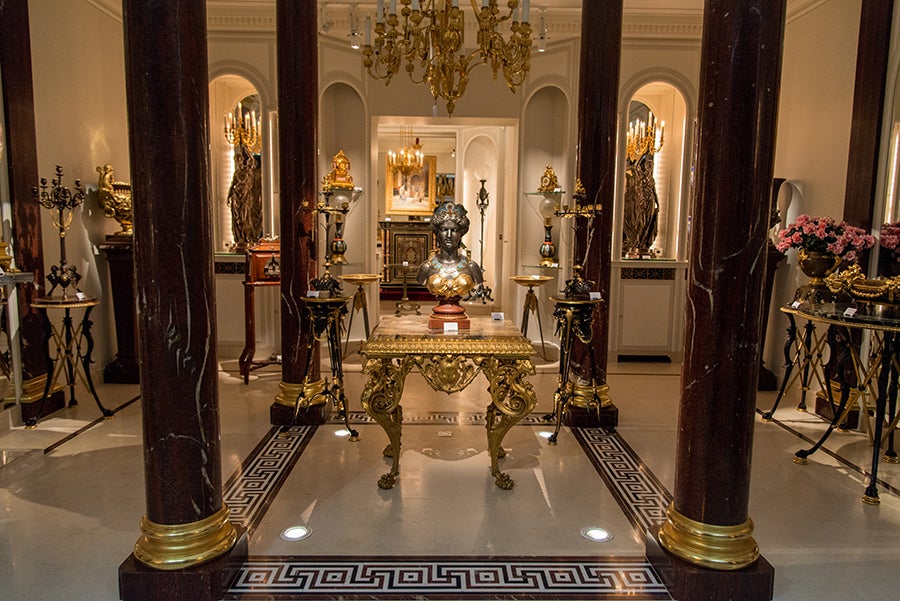
About the Seller
4.9
Gold Seller
Premium sellers maintaining a 4.3+ rating and 24-hour response times
Established in 1997
1stDibs seller since 2018
85 sales on 1stDibs
Typical response time: <1 hour
Associations
International Confederation of Art and Antique Dealers' Associations
- ShippingRetrieving quote...Shipping from: PARIS, France
- Return Policy
Authenticity Guarantee
In the unlikely event there’s an issue with an item’s authenticity, contact us within 1 year for a full refund. DetailsMoney-Back Guarantee
If your item is not as described, is damaged in transit, or does not arrive, contact us within 7 days for a full refund. Details24-Hour Cancellation
You have a 24-hour grace period in which to reconsider your purchase, with no questions asked.Vetted Professional Sellers
Our world-class sellers must adhere to strict standards for service and quality, maintaining the integrity of our listings.Price-Match Guarantee
If you find that a seller listed the same item for a lower price elsewhere, we’ll match it.Trusted Global Delivery
Our best-in-class carrier network provides specialized shipping options worldwide, including custom delivery.More From This Seller
View All« The Musician » Japanese style Clock attr. to L'Escalier de Cristal, FR, c.1890
By L'Escalier de Cristal
Located in PARIS, FR
Amusing bronze with double patina and porcelain clock in the shape of a covered jar.
This clock, with a dial with Arabic numerals decorated in its center with a seated lute player, i...
Category
Antique 1890s French Japonisme Mantel Clocks
Materials
Bronze
"Pagoda" Clock attr. to L'Escalier de Cristal, France, circa 1885
By L'Escalier de Cristal
Located in PARIS, FR
Beautiful Japonisme clock in openwork patinated bronze with gold and silver highlights in the shape of a pagoda, at the corners presenting stylized dragons above uprights imitating b...
Category
Antique 1880s French Japonisme Mantel Clocks
Materials
Bronze
Japanese Style Clock attr. to L'Escalier de Cristal, France, Circa 1885
By L'Escalier de Cristal
Located in PARIS, FR
Rare Japanese clock in double patina bronze with suspended dial.
The portico and dial, with calligraphic Kanji numerals complemented by hands featuring an undulating dragon, are deco...
Category
Antique 1880s French Japonisme Mantel Clocks
Materials
Bronze
Giltwood Thermometer & Perpetual Calendar Attributed to F.Linke, France, c. 1880
By François Linke
Located in PARIS, FR
Elegant Louis XVI style set comprising a thermometer and a perpetual calendar attributed to F. Linke. Each consisting of a metal plaque, painted with floral motifs on a beige backgro...
Category
Antique 1880s French Louis XVI Scientific Instruments
Materials
Sheet Metal
Neo-Egyptian Bronze and Marble Clock Attributed to G.Servant, France, Circa 1870
By Georges Emile Henri Servant
Located in PARIS, FR
A black and red marble clock in the shape of an Egyptian temple attributed to G. Servant, flanked by double columns inscribed with hieroglyphs and ornated with a winged uraeus, all made in two patina bronze. The clock is surmounted by a patinated bronze sphinx. Resting on four bronze faces wearing the nemes and terminating in lion paw feet.
Georges Emile Henri Servant (circa 1828-1890) who took over his father in 1855 at their foundry, rue Vieille-du-Temple, in Paris, specialized in the production of neo-Egyptian style clocks, very popular in France since 1860s, and also the making of Greek style decorative objects. He drew considerable attention to the high quality of his bronzes at the 1855 Paris Universal Exhibition and then at the 1862 London Exhibition. At this time Servant exported up to 40% of his production, principally to the United States, where for instance, his sphinx clocks were sold with great success by Louis Tiffany Inc. or Hamann & Roche of New York (A similar clock is now exposed at the Metropolitan Museum of Art, New York). But his success came really at the 1867 Paris Universal Exhibition, where he was awarded a gold medal for his neo-Greek and Egyptian works (Les Merveilles...
Category
Antique 1870s French Egyptian Revival Mantel Clocks
Materials
Marble, Bronze
Neo-Egyptian Marble Clock Attributed to G. Servant, France, Circa 1870
By Georges Emile Henri Servant
Located in PARIS, FR
Black and red marble pyramid shaped Egyptian style clock attributed to G. Servant, surmounted by a patinated bronze figure representing the Egyptian goddess Isis sitting on her throne. Wearing the Hathor hairdress (the solar disc surrounded by the sacred cow horns), she holds in her right hand the Ouadj, the goddesses scepter surmounted by a canopy of papyrus, symbolizing health and eternal youth and in her left hand, the cross of life Ankh, symbol of rebirth and eternity.
That Egyptian style in fashion since Napoleon the First and his military campaigns in Egypt around 1799 was rediscovered in France in the 1830's and above all in the 1860's. Some renowned French artists, such the sculptors and bronze-casters Guillaume Denière (1815-1903), Emile Hébert (1828-1893) et Georges Servant (1828-1890), presented at the 1867 and 1878 Paris Universal Exhibitions, an a-part section dedicated to their Egyptian style production. Their shows drew then considerable attention from the public and the wealthy collectors. During the 1867 Universal Exhibition, one could admire the Stand realized by the French silversmith-jeweller Gustave Baugrand (1826-1870), where his works executed in most Fine materials took inspiration from the Egyptian Antiques, exhibited then in the Louvre museum.
Georges Emile Henri Servant (1828-c.1890), who took over his father in 1855 at their foundry, rue Vieille-du-Temple, in Paris, specialized in the production of neo-Egyptian style clocks, very popular in France since 1860’s, and also the making of Greek style decorative objects. He drew considerable attention to the high quality of his bronzes at the 1855 Paris Universal Exhibition and then at the 1862 London Exhibition. At this time Servant exported up to 40% of his production, principally to the United States, where for instance, his clocks were sold with great success by Louis Tiffany Inc. or Hamann & Roche of New York. But his success came really at the 1867 Paris Universal Exhibition, where he was awarded a gold medal for his neo-Greek and Egyptian works (Les Merveilles...
Category
Antique 1870s French Egyptian Revival Table Clocks and Desk Clocks
Materials
Marble, Bronze
You May Also Like
A French ‘Chariot’ Three-pieces Clock Garniture attributed to F.Linke circa 1890
By François Linke
Located in Saint-Ouen, FR
A French Ormolu and Patinated-Bronze ‘Chariot’ Three-pieces Clock Garniture
Attributed to François Linke (1855 - 1946), Paris, Late 19th/ Century
The clock representing a putto on ...
Category
Antique 1890s French Napoleon III Mantel Clocks
Materials
Bronze, Enamel, Ormolu
Louis XVI Style Gilt Bronze and White Marble Clock By François Linke, circa 1890
By François Linke
Located in Brighton, West Sussex
A fine Louis XVI style gilt bronze and white marble clock depicting Diana and Cupid, by François Linke.
French, circa 1890.
Signe...
Category
Antique Late 19th Century French Louis XVI Mantel Clocks
Materials
Marble, Bronze
Fine French Gilt-Bronze and Rouge Griotte De Campan Table Clock by Léon Messagé
Located in New York, NY
Maker: Léon Messagé (1842-1901)
Origin: Paris, France
Date: Early 20th century
Size: 11 3/4 in x 9 in x 6 1/4 in.
Signature: signed Messagé to the right side of the lion pelt...
Category
Antique 19th Century French More Clocks
Materials
Bronze
French Gilt Mantle Clock by Linke French 1890 Cherub
Located in Potters Bar, GB
Highly collectable French gilt mantle clock by Francois Linke
Piece is signed on the base, please see close up photo
The casting and intricacy to the gilt is incredibly detailed
Clas...
Category
Antique 1890s Mantel Clocks
Materials
Glass
Francois Linke Louis XVI Style Gilt Bronze and Marble Mantel Clock Garniture
Located in New York, NY
Exceptional garniture in the Louis XV/XVI style with gilt bronze mounts attributed to Léon Messagé (1842-1901) and Francois Linke (1855-1946), including mantel clock and pair of cand...
Category
Early 20th Century French Louis XV Mantel Clocks
Materials
Marble, Bronze
A Louis XVI Style Mantel Fine Gilt-Bronze Clock by François Linke
By François Linke
Located in Brighton, West Sussex
A Very Fine Gilt-Bronze Clock With A White Marble Base by François Linke.
The case signed 'Linke'.
This rare example of a clock by François Linke has a twin train eight-day mov...
Category
Antique 19th Century French Louis XVI Mantel Clocks
Materials
Marble, Enamel, Ormolu
Recently Viewed
View AllMore Ways To Browse
A L Holding
Circa 1882
Sculptors Modeling Stand
Rococo Bronze Table
Potting Work Table
French Potting Table
Life Size Artist Model
French Trellis
Gilt Trophy
Antique Desk Ornaments
Terra Bronze
18th Century Gold Medal
Louis Xvi Desk 18th
18th Century Stand Desk
Antique Rococo Style Gold Table
Allegory Bronze
Trellis Table
Leon Message
